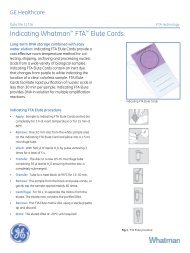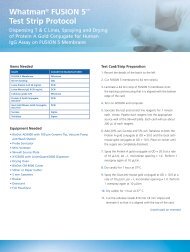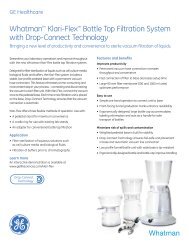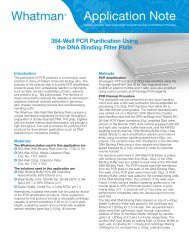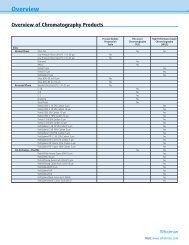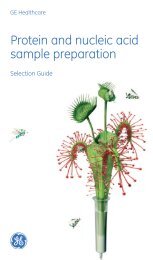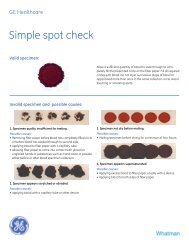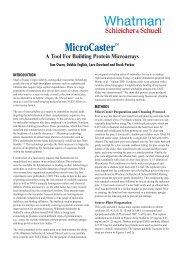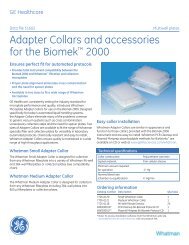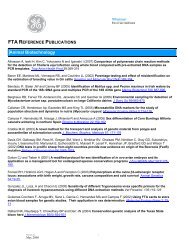Whatman FTA® Elute
Whatman FTA® Elute
Whatman FTA® Elute
You also want an ePaper? Increase the reach of your titles
YUMPU automatically turns print PDFs into web optimized ePapers that Google loves.
N<br />
<strong>Whatman</strong> FTA ® <strong>Elute</strong><br />
Part of the <strong>Whatman</strong> family of<br />
innovative FTA products, <strong>Whatman</strong><br />
FTA <strong>Elute</strong> provides a new level of speed<br />
and convenience for your DNA research.<br />
FTA <strong>Elute</strong> combines stable long-term<br />
room temperature DNA archiving with<br />
easy elution, allowing you to create<br />
multiple amplifications from a single<br />
sample. In fact, FTA <strong>Elute</strong> provides as<br />
much as 100 µL of DNA template<br />
from just one punch. The eluted DNA<br />
can be measured quantitatively with<br />
commercially available kits. Imagine<br />
not having to rely on expensive freezer<br />
systems for your DNA archiving. Now<br />
you can collect samples easily, store them<br />
at room temperature and release DNA<br />
into solution with a simple water and<br />
heat elution step.<br />
Applications<br />
• Biobanking<br />
• Pharmacogenomics<br />
• Genotyping<br />
• Rapid DNA Isolation<br />
• Molecular Diagnostics<br />
• Genetic Identification<br />
• Transgenics<br />
• PCR<br />
N<br />
CL<br />
Long-term DNA storage at room temperature combined with<br />
easy elution for multiple applications from a single sample<br />
ADVANTAGES BENEFITS<br />
Samples can be collected, shipped • Eliminates high costs associated with shipping samples on ice<br />
and stored at room temperature • Eliminates high costs associated with laboratory freezer<br />
storage requirements<br />
Rapidly inactivates organisms, • Eliminates the risk of contamination for the individuals handling<br />
including blood borne pathogens the sample<br />
• Eliminates classifying samples as biohazards<br />
Sample processing time to isolate • Eliminates lengthy and multiple step isolation procedure<br />
DNA is 5-30 minutes (4-16 hours)<br />
Sample processing requires a • Eliminates cost of using a purification kit<br />
simple water elution procedure<br />
to isolate DNA<br />
Sample volume requirements • Eliminates venous blood samples and large blood volume<br />
handling/processing are minimal: • Eliminates the need for venipuncture equipment and medical<br />
12-40 µL per collection area attendant at the site of collection<br />
Hemoglobin, a known PCR inhibitor, • Yields DNA free of PCR inhibitors<br />
is bound to the FTA <strong>Elute</strong> matrix<br />
Collect and isolate samples quickly<br />
and easily<br />
Blood Sample Collection and Isolation of DNA Template<br />
30 Minute Isolation<br />
1. Blood sample<br />
collection on FTA <strong>Elute</strong>.<br />
Dry thoroughly.<br />
2. Punch out a 3 mm sample<br />
with a sterile punch<br />
and place into a sterile<br />
microcentrifuge tube.<br />
3. Rinse punch in 500 µL of<br />
dH 2O by vortexing 3X for<br />
5 seconds.<br />
4. Using a sterile pipette,<br />
remove water; centrifuge<br />
5 seconds; pipette off<br />
excess.<br />
5. Add 50 µL sterile<br />
water; heat to 95°C<br />
for 30 minutes; DNA<br />
template is now ready.<br />
6. Add 5-10 µL<br />
template to PCR<br />
reaction mixture.
The rapid identification of tens of thousands of human genes<br />
and hundreds of thousands of DNA variations that may influence<br />
disease susceptibility has created the field of pharmacogenomics.<br />
Pharmacogenomic companies are involved in quantifying and<br />
cataloguing human genetic variation and using algorithms to<br />
tease out correlations among biomarkers, genes, diseases and<br />
drug response with the promise of personalized medicine.<br />
SNP Genotyping is at the heart of pharmacogenomics and<br />
personalized medicine. SNP Genotyping, comparative DNA<br />
analysis, is utilized for determining the predisposition of<br />
individuals to certain diseases or medical disorders. SNPs are<br />
also found in genes for drug-metabolizing enzymes, thus<br />
influencing an individuals' ability to process a drug properly.<br />
By linking specific diseases with specific SNPs, potential drug<br />
targets may be developed for personalized therapy.<br />
There are many methods by which genotyping may be<br />
performed. Sequencing, TaqMan ® , Molecular Probes (Invitrogen),<br />
mass extension, agarose gel electrophoresis and Scorpions <br />
ARMS technology are among the most common methods to<br />
perform genotyping analyses.<br />
FTA ® <strong>Elute</strong> not only provides a simple purification methodology<br />
but also provides high quality DNA for a multitude of<br />
applications—from biobanking, pharmacogenomics and<br />
genotyping to diagnostics.<br />
The following experiments were conducted: Real Time PCR,<br />
Whole Genome Amplification, Sequencing, Multiplex Gene<br />
Deletion Assay, ARMS Scorpions Genotyping and Scorpions<br />
ASO Genotyping. The results from these experiments clearly<br />
demonstrate the high quality of DNA obtained from FTA <strong>Elute</strong>.<br />
Figure 1: Real-Time PCR Plots of 10 Test Samples<br />
Ten individual samples of DNA purified using FTA <strong>Elute</strong> were prepared for real time PCR of an in-house<br />
reference DNA fragment. For this assay 2.5 µL of the extracted DNA was mixed with the DNA binding dye<br />
Yo-Pro 1 (Invitrogen) to monitor real-time PCR Amplification. A no template control was included in the<br />
assay and appears as the flat line at the bottom of the profile.<br />
Real Time PCR*<br />
DNA eluted from the FTA <strong>Elute</strong> punches was subjected to<br />
quantitative PCR to demonstrate the quality of the purified DNA.<br />
Blood samples were collected from 10 separate individuals onto<br />
FTA <strong>Elute</strong> cards and the cards were allowed to dry completely.<br />
Punches (3.0 mm) were extracted according to the water and<br />
heat elution protocol in a final volume of 100 µL. Approximately<br />
2.5 µL of the purified DNA was added to the real time PCR<br />
mixture and amplified using the Yo-Pro 1 DNA binding dye<br />
(Invitrogen). Figure 1 shows a very tight grouping of curves with<br />
an average Ct of 26.58 which equals 22.14 ng of DNA in the<br />
100 µL final volume. Considering the samples are from 10<br />
individuals any variability seen in the Ct values are due to<br />
individual variability (as would be seen in a white blood cell<br />
count). The data is highly reproducible from the 10 individual<br />
samples showing the high quality of DNA purified using FTA<br />
<strong>Elute</strong>. The yield of DNA from FTA <strong>Elute</strong> is sample dependent.<br />
For blood, over a large number of different determinations,<br />
yields ranges are 55–70%. For buccal, over a large number<br />
of different determinations, yield is generally higher, 60–75%.<br />
The easy extraction procedure also demonstrates that the<br />
DNA obtained is amenable to high throughput genotyping.<br />
Figure 2: TaqMan ® Genotyping of Whole Genome Amplified DNA<br />
from FTA <strong>Elute</strong><br />
Allele Y (Allelle 2)<br />
5.00<br />
4.50<br />
4.00<br />
3.50<br />
3.00<br />
2.50<br />
2.00<br />
1.50<br />
1.00<br />
0.50<br />
Allele Y Controls<br />
Allele X Controls<br />
Allele X and Y Controls<br />
No Template Controls<br />
Test Samples<br />
Allelic Discrimination<br />
0.00<br />
0.00 0.40 0.80 1.20 1.60 2.00 2.40 2.80 3.20<br />
Allele X (Allele 1)<br />
Whole Genome Amplification<br />
DNA was purified from whole blood spots stored for<br />
0, 2 and 8 years on FTA <strong>Elute</strong> and amplified by REPLI-g ®<br />
methods. The amplified DNA was then genotyped for a<br />
single SNP in replicates of 5 and compared to authentic<br />
genomic DNA controls.<br />
DNA purified from blood on FTA <strong>Elute</strong> was subjected to whole<br />
genome amplification (WGA) using the REPLI-g ® (Qiagen)<br />
method. The amplified DNA then underwent genotyping<br />
with the TaqMan ® method (Figure 2). There is excellent allelic<br />
discrimination obtained with this method. Blood spots dried on<br />
FTA <strong>Elute</strong> for 0, 2 and 8 years served as templates for WGA and<br />
the DNA amplified from the FTA <strong>Elute</strong> was then analyzed for<br />
SNP 1004. The WGA DNA performed in genotyping assays as<br />
well as authentic genomic DNA purified by other methods.<br />
These results demonstrate that DNA stored and purified from<br />
FTA <strong>Elute</strong> can serve as an unlimited supply of DNA for current<br />
and future genotyping studies.
Figure 3: Genotyping by DNA Sequencing Figure 4: Multiplex Gene Deletion Assay for UGT2B17<br />
Deletion Assay—Multiplex PCR Genotyping<br />
Sequencing*<br />
DNA sequencing is the “gold standard” Sample Genotype<br />
for detecting polymorphisms in gene<br />
sequences. In order to demonstrate<br />
the quality of the DNA eluted from<br />
Individual 1<br />
Individual 2<br />
G/G<br />
T/T<br />
FTA <strong>Elute</strong>, a 1.05 kb fragment from<br />
Individual 3 G/T<br />
exon 1 of the 2B15 variant of the Individual 4 G/G<br />
UDP-glucuronosyltransferase (UGT) Individual 5 G/G<br />
gene was amplified by PCR, then Individual 6 G/T<br />
subjected to sequencing. DNA from Individual 7 T/T<br />
10 individuals were tested for the G>T Individual 8 G/G<br />
polymorphism at the D85Y loci (Table 1). Individual 9 T/T<br />
Representations of homozygous wild<br />
type G/G, heterozygous wild type/<br />
Individual 10 G/G<br />
mutant G/T and homozygous mutant T/T base pair changes<br />
are shown in Figure 3; the positions of the polymorphisms are<br />
indicated by an arrow. The profile indicates that the DNA<br />
extracted from FTA <strong>Elute</strong> yields excellent sequencing data. The<br />
peaks are clean, well defined and show high quality delineation.<br />
Multiplex Gene Deletion Assay*<br />
DNA samples from FTA ® <strong>Elute</strong><br />
were used to amplify a 1.05 kb<br />
exon 1 fragment of the<br />
UGT2B15 gene. The PCR<br />
product was treated with<br />
ExoSAP-IT ® (USB). Sequencing<br />
reactions using ABI Big Dye <br />
v 1.1 were carried out on<br />
an MJ Research Tetrad ®<br />
instrument. Sequencing<br />
reactions were cleaned up<br />
using ABgene Dye Terminator<br />
Removal Kits and run on an<br />
ABI Prism ® 3100 instrument.<br />
Table 1<br />
Many labs perform multiplex gene deletion assays using end-point<br />
PCR and agarose gel electrophoresis as a means of genotyping.<br />
The presence or absence of bands for a large deletion is clearly<br />
visible on the gels. Figure 4 shows a multiplex PCR performed<br />
with DNA purified from FTA <strong>Elute</strong> to detect a deletion in<br />
the UGT2B17 gene. The wild type and mutant genes are<br />
demonstrated by bands of 316 bp and 884 bp, respectively.<br />
As can be seen the individual in lane 7 is homozygous for the<br />
mutant form of the gene.<br />
The ability to multiplex with multiple primers is dependent<br />
on high quality DNA to prevent mis-priming and non-specific<br />
banding patterns. The DNA purified by FTA <strong>Elute</strong> is very robust<br />
and less than 1 ng is required to yield clean strong bands in the<br />
multiplex PCR.<br />
Amplicons from a multiplex PCR were separated on a 1.5% Agarose gel. Lanes 1–10 are reactions<br />
using DNA from 10 separate individuals. The control lanes demonstrate the possible genotypes:<br />
A wt/wt; B wt/mut; C mut/mut. The Abgene Electrofast MWMarker Ladder: 250 bp, 500 bp,<br />
1000 bp is in Lanes M.<br />
ARMS Scorpions Genotyping*<br />
Amplification Refractory Mutation System (ARMS ) and Scorpion <br />
probes is a homogeneous platform for molecular analysis and<br />
genotyping. It is a very sensitive system detecting only a few<br />
molecules of interest even in the presence of high background.<br />
This platform is fast and excellent for detecting difficult sequence<br />
stretches such as high GC content.<br />
Blood samples from 10 individuals were collected onto FTA <strong>Elute</strong><br />
matrix and processed for genotyping analysis of the UGT2B15*2<br />
gene. The samples were run in sets of 4 replicates and plotted as<br />
a function of the fluorescence of the two dyes HEX and FAM.<br />
Figure 5 shows a clear distinction between heterozygous and<br />
homozygous samples. This type of data demonstrates that<br />
FTA <strong>Elute</strong> yields a very clean DNA template that is reproducible<br />
and excellent for use with the highly sensitive ARMS<br />
Scorpions technology.<br />
Figure 5: ARMS Scorpions Genotyping<br />
Genotyping was performed on 4 replicates each of 10 different DNA samples purified on FTA <strong>Elute</strong>.<br />
This assay was performed on a Stratagene Mx3000P ® Real-time PCR machine. ARMS Scorpion<br />
assays use the specificity of ARMS combined with the signaling of Scorpion probes to generate<br />
data. Fluorescence readings were taken pre- and post-PCR. The data shows 3 discrete genotype<br />
populations: mut/mut, wt/mut, wt/wt. NTC refers to no template control.
Scorpions ASO Genotyping*<br />
Another technology for genotyping is using allele specific oligonucleotide (ASO)<br />
probes in conjunction with the Scorpion homogeneous platform. This method<br />
provides the fluorescent tag necessary to monitor real time PCR while the ASO<br />
supplies the quencher. This method is similar to other existing methods of<br />
genotyping like Molecular Beacons, TaqMan ® and other probe based methods<br />
of genotyping. Figure 6 shows 10 separate DNA samples from blood collected on<br />
FTA <strong>Elute</strong> and purified by a simple water heat elution method. The data separates<br />
out into clear groupings of heterozygous and homozygous samples for the NAT2*5<br />
gene. These results show that the DNA purified by FTA <strong>Elute</strong> is compatible with all<br />
major means of real time PCR based genotyping and can be included in high<br />
throughput genotyping operations.<br />
Figure 6: ASO Genotyping<br />
Genotyping was performed on 4 replicates each of 10 different DNA samples purified on FTA <strong>Elute</strong>. This assay was performed<br />
on a Stratagene Mx3000P ® Real-time PCR machine. ASO Scorpion assays use the specificity of allele specific probes combined<br />
with fluorescence signalling to generate data. Fluorescence readings are taken pre and post-PCR.<br />
<strong>Whatman</strong> FTA <strong>Elute</strong>—Key to High Quality DNA<br />
If your goal is to obtain pure, high quality DNA free of inhibitors for your<br />
critical research, then <strong>Whatman</strong> FTA <strong>Elute</strong> will be an invaluable addition to<br />
your DNA toolbox. DNA purified with FTA <strong>Elute</strong> is suitable for a wide variety<br />
of molecular applications.<br />
Recommended Protocol<br />
This protocol is recommended if you need a large amount of DNA. If your testing does not require a lot of DNA,<br />
then typically you can use one 3 mm punch and follow the protocol on page 1.<br />
1) Punch 3 circles from the centre of a blood spot using a 3.0 mm paper punch into a sterile 1.5 mL microfuge<br />
tube. To prevent cross contamination between samples, punch a clean piece of filter paper 3 times after<br />
punching out each sample.<br />
2) Wash the punched circles by adding 500 µL of sterile water to the tube and pulse vortex 3 times,<br />
for a total of 5 seconds.<br />
Please note: If the wash is pink, the blood sample was not completely dried. Discard these punches<br />
and thoroughly dry the remaining blood spots before re-punching the card and repeating step 2.<br />
3) Using a sterile pipette remove excess wash water from the tube and gently squeeze the circles against<br />
the side of the tube to remove as much water as possible.<br />
4) Add 100 µL of sterile water to the tube. Ensure the circles are completely immersed in the water by briefly<br />
pulse centrifuging the tube for 5 seconds.<br />
5) Transfer the tube to a heating block at 95oC-100oC for 15-30 minutes.<br />
6) At the end of the incubation period remove the sample from the block and pulse vortex the sample<br />
approximately 60 times.<br />
7) Briefly centrifuge to separate the paper punch from the eluant. The eluant now contains the<br />
extracted DNA.<br />
8) Using a sterile pipette tip gently remove the spent blood spot circles from the tube and discard them<br />
into a biohazard container.<br />
9) Store the eluted DNA at –20oC until required.<br />
WHATMAN CATALOG ORDERING INFORMATION<br />
<strong>Whatman</strong><br />
Catalog Number Description Quantity/Pack<br />
WB120410 FTA <strong>Elute</strong> Micro Card 100<br />
WB120401 FTA <strong>Elute</strong> Micro Card 25<br />
<strong>Whatman</strong> Quality<br />
<strong>Whatman</strong> is a global leader in separations technology and is<br />
known in the scientific community for providing innovative Life<br />
Science products and solutions. Our instinct for simplification<br />
accelerates the rate of discovery, reduces costs and saves time.<br />
For more information, visit www.whatman.com.<br />
<strong>Whatman</strong> ® , FTA ® and FTA ® <strong>Elute</strong> are registered trademarks of<br />
the <strong>Whatman</strong> Group. Scorpions is a trademark of DxS Limited<br />
and ARMS is a trademark of AstraZeneca Limited. TaqMan ®<br />
is a registered trademark of Roche Molecular Systems, Inc.<br />
REPLI-g ® is a registered trademark of the QIAGEN Group.<br />
BigDye is a trademark of PE Corporation. ExoSAP-IT ® is a<br />
registered trademark of USB Corporation. Tetrad is a trademark<br />
of MJ Research, Inc. ABI Prism ® is a registered trademark of<br />
Applied Biosystems.<br />
*Experiments referenced in this application note were<br />
conducted by DxS Limited.<br />
North America <strong>Whatman</strong> Inc.<br />
200 Park Avenue, Suite 210<br />
Florham Park, NJ 07932 USA<br />
Tel: 1-800-WHATMAN (US and Canada)<br />
Fax: 1-973-245-8329<br />
Email: info@whatman.com<br />
Europe <strong>Whatman</strong> International Ltd<br />
Springfield Mill, James <strong>Whatman</strong> Way<br />
Maidstone, Kent<br />
ME14 2LE UK<br />
Tel: + 44 (0) 1622 676670<br />
Fax: + 44 (0) 1622 677011<br />
Email: information@whatman.com<br />
<strong>Whatman</strong> GmbH<br />
Hahnestrasse 3<br />
D-37586 Dassel<br />
Germany<br />
Tel: + 49 (0) 5564 204 100<br />
Fax: + 49 (0) 5564 204 533<br />
Email: information@whatman.com<br />
Japan <strong>Whatman</strong> Japan KK<br />
JPR Ichigaya Building 6F<br />
4-7-15, Kudan-Minami, Chiyoda-ku<br />
Tokyo 102-0074 Japan<br />
Tel: +81 (0) 3 5215 1240<br />
Fax: +81 (0) 3 5215 1245<br />
Email: japaninfo@whatman.com<br />
Asia Pacific <strong>Whatman</strong> Asia Pacific Pte Ltd.<br />
1 Kim Seng Promenade #15-12<br />
Great World City, West Tower<br />
Singapore 237994<br />
Tel: +65 6534 0138<br />
Fax +65 6534 2166<br />
Email: wap@whatman.com<br />
Leaders in Separations Technology<br />
www.whatman.com<br />
51691(US) S9036-804 (EU) 12/06





